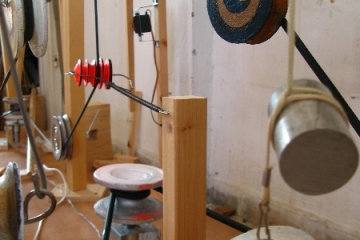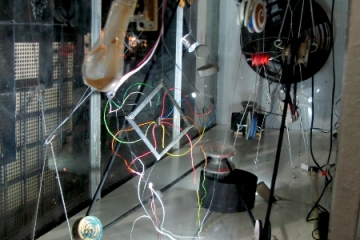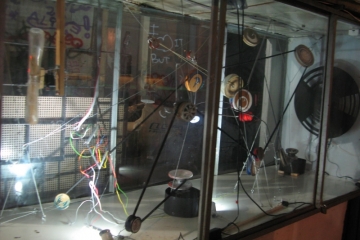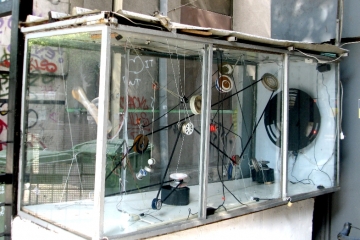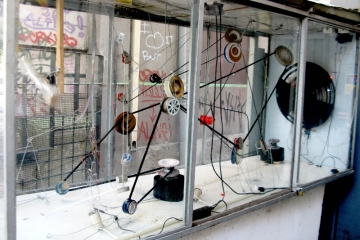Reason & Outcome, Tel Aviv, Vitrine, 2012
Interactive kinetic installation
Was first made for the display window “Havitrina”, Hameorav bar at 97 Allenby Street, Tel Aviv, curated the project Ruth Patir.
The work is composed from the cables, pulleys, straps, weights and springs which are in a state of motion and mutual influence. Some pulleys are fixed to one point and some are connected via cable, spindle, weight or spring, creating a range of positions where they can be found, and thus affects the movement of other parts of the system. The back and the front pair of servo motors, one for a paper cut disc and the other for an Hourglass, each at different movement and direction. The work creates a reaction of the parts according to the movement of passersby and viewers:
1. Rate is affected by the amount of traffic passing by.
2. Movement of parts is determined by the distance of people looking into the window.
At the front a rhombus wood and wire braid which leads to the driver, the chip that connects the microprocessor to the motors and directs voltage flow to them.
The work is the result of a study regarding time, movement, relationships, weight, power relations and relations of movement, randomness and feedback. It creates a tangle of moving objects simultaneously and which are interconnected – influence each other and are influenced by each other. Flexibility of the strip, tension of the springs, cable lengths, wheel rotation rate, fluctuations in weight, engine power and ability to meet resistance and other parameters of each part self-dynamics are contributing to the degree of the chaotic system. Fluctuation of the system between states of stress and looseness, movement and static, linear motion and irregular motion creating admissions dynamics of living systems.
Trying keeping track of the events in the system, another order of things, figuring out what causes what, what comes first and how it affects the system, how the viewer’s movement changes the direction and rate of movement of parts, requires the ability to estimate time and to be able to create segmentation in it which takes each of the parts to accomplish its cycle. This may be what the hourglass can be used for, but also this one isn’t reliable and is dependent on the movement of the viewer and change the its pace and direction of time accordingly, which make it only to add scramble to the sense of time. The appearance of the driver inside the rhombus actualizes what is hidden from view, the movement of electrons passing electrical currents through it and through the microcontroller feeding the system with information, the inputs and outputs. The wires color is defined according to its functionality and the data type it transmits. The work is influenced by conceptions derived from chaos, complexity and the knot theories.
Special Thanks: Amir Markovitch, Eitan Cahana, Ido Cherny
